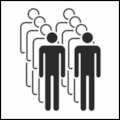Facts and data on pictograms

Synonyms / Other Terms Used
Queuing, Line Up, Line Up Here, Line Up Two By Two, Line up in threes, ...
Category
Behaviour of the Public, Regulations
Message / Function
To indicate the necessity to queue (in single file, in lines of two, ...) for access to facility
| Source | Description | |
|---|---|---|
 |
Gan Khoon Lay | Perspective view of line of eight human figures |
 |
Transport for London |
Line of six human figures |
 |
BS 8501:2002 | Line of six human figures |
 |
Eco-Mo Foundation |
Line of five human figures, every other figure with inverted colors |
 |
CNIS | Front view of line of figures, first one solid, other three in outline |
 |
ISO 7001 | Front view of line of figures, first one solid, other two in outline |
 |
D'source | Detail view of line of four human figures, first one solid, some parts in outline |
 |
D'source | Detail view of line of four female figures, first one solid, some parts in outline |
 |
D'source | Detail view of line of four female figures, first one solid, some parts in outline |
 |
Teuku Syahrizal | Line of three human figures, arrow parallel to queue |
 |
Eco-Mo Foundation |
Line of ten human figures, two by two, every other row with inverted colors |
 |
CNIS | Front view of two lines of figures, front ones solid, remainder in outline |
 |
ISO 7001 | Front view of two lines of figures, front ones solid, remainder in outline |
 |
CNIS | Front view of three lines of figures, front ones solid, remainder in outline |
 |
ISO 7001 | Front view of three lines of figures, front ones solid, remainder in outline |
 |
EMF Pred | Line of nine human figures, three by three, second row with inverted colors |
Note: Some of the examples shown above were mirrored horizontally to contrast differences.
Discussion
The number of designs available is rather limited. Different points of view result in varying angles at which the queues are displayed, and the number of persons behind each other range from three to eight. Using perspective view as in the variant from Gan Khoon Lay might lead to less clear results when displaying lines of two or more. In our research we found even lines of six and eight, being used at the boarding area of chair lifts. In such environments queueing in correct groups is important to utilize maximum transportation capacity available.
Test data is sparse:
In a Japanese study to propose domestically unified graphical symbols based on scientific methods, the pictogram variant labeled as Eco-Mo Foundation in the table above reached a comprehension score of 79.7 on basis of a multiple choice test with just three distractors (Eco-Mo Foundation, 2001), so depending on the distractors used data might overestimate real world comprehensibility. This variant was tested as mandatory sign in white on blue.
Recommendations
We suggest to compare the concepts available to identify the best image content. The study design should also include a Comprehension Test to identify possible misinterpretations and to improve designs. Only on such a basis a clear decision concerning a specific recommendation can be reached.



Until then nothing is to be said against using variants similar to the variants from the Chinese standard GB/T 10001 as we expect comprehensibility of these pictograms to fulfill ISO requirements. These pictograms also are identical with the images presented with the corresponding referents in the Austrian standard S 4610.
Tests of pictograms of referent Queue
Eco-Mo Foundation (2001): Test data of public information symbols in Japan - Procedure for the testing of public information symbols by the Study Committee. ISO: ISO/TC 145/SC 1 N 329.
See also
Updated 2024-12-08 by Ch.Brugger